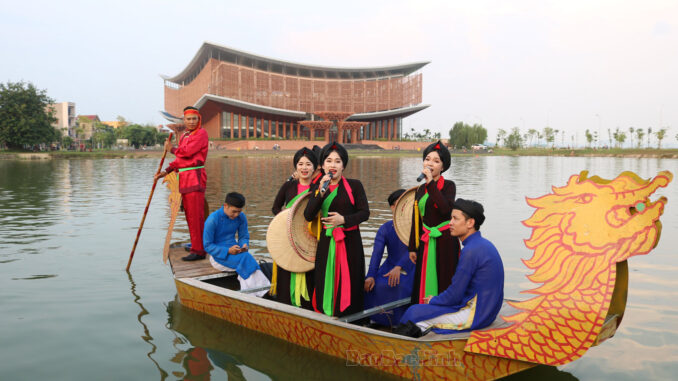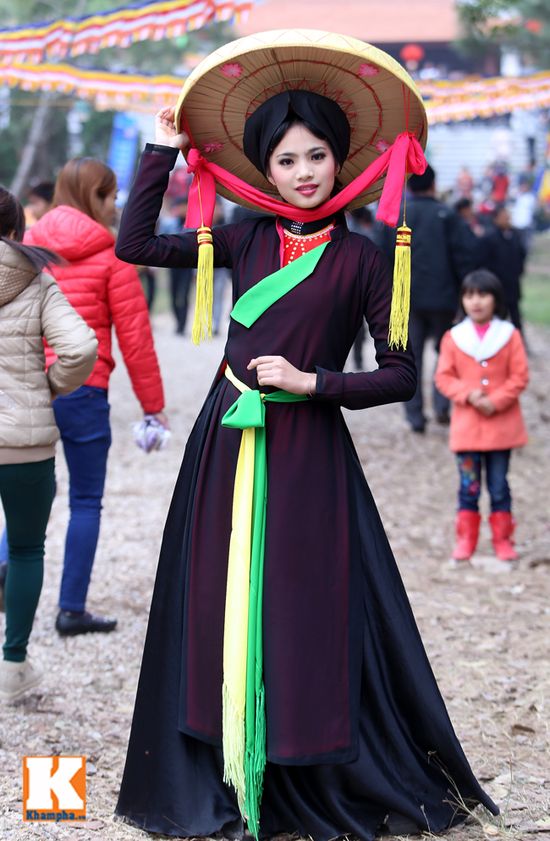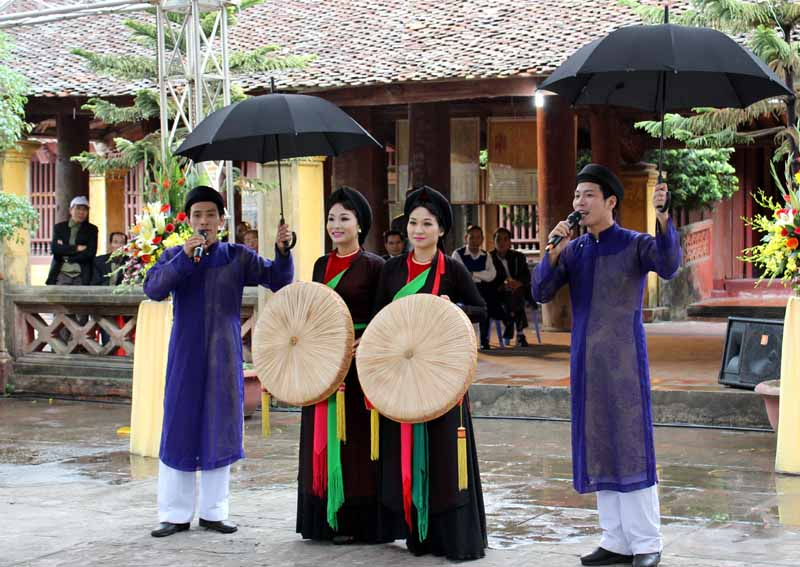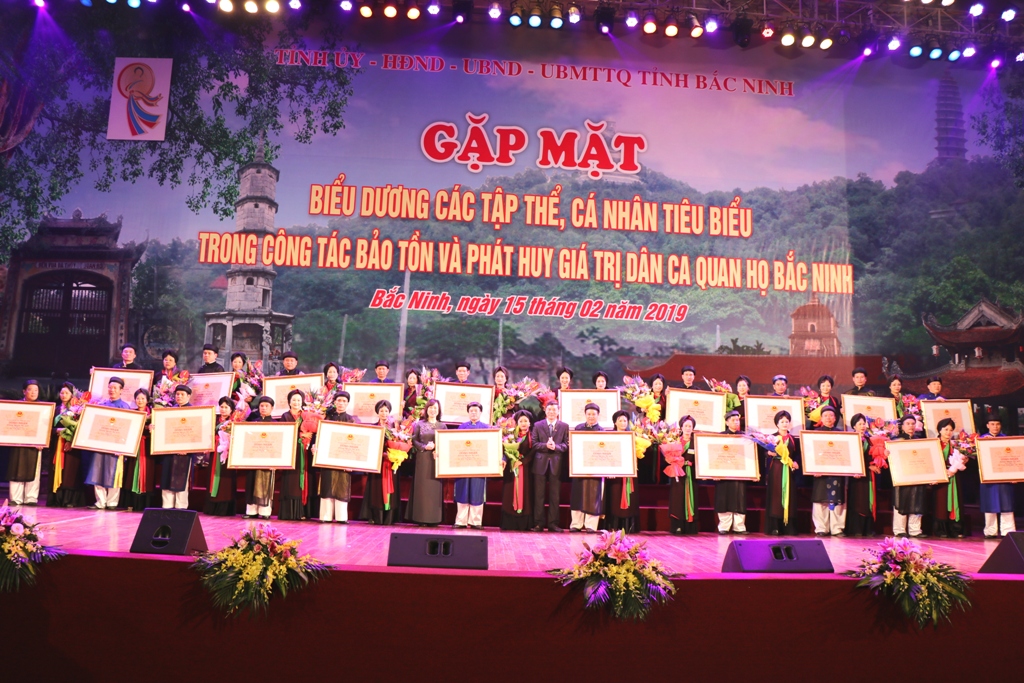
Quan Ho Bac Ninh is a category of folk songs of the Red River Delta, concentrated mainly in Kinh Bac region (Bac Ninh and Bac Giang provinces). Quan ho is the combination of many elements like music, lyrics, costumes, and festivals… ex-pressing pure and nice thoughts of local peasants in villages who mainly practice wet rice cultivation. Performing Quan ho folk songs requires careful training with strict regulations on organization and performance.
Introduce
Bac Ninh Quan Ho folk songs are a form of love song between brothers and sisters. This is one of the typical folk songs of the Red River Delta.
Men dressed in traditional turbans and ao dai, and graceful women in long-sleeved shirts and basket-shaped hats with straps on their heads sang simple, loving verses, singing together. Traditionally, there is no need for accompaniment but is still full of music, showing the sophisticated culture of Quan Ho singers.
History
Every year, every spring and fall, the people of 49 original Quan Ho villages in Kinh Bac (including today’s Bac Ninh and Bac Giang), no matter where they are, return to their homeland to worship. Attending communal house festivals, and pagoda festivals, festivals are unique because they have been associated with Quan Ho performances for many generations.
Because it was born a long time ago, Bac Ninh Quan Ho has many stories about its birth. Some say that Quan Ho dates back to the 11th century, others say that it dates back to the 17th century, but all, survey and research projects up to now, although different, have all affirmed the great value of Quan Ho’s intangible cultural heritage, especially Quan Ho folk songs, an art form recognized considered the core of Kinh Bac culture for thousands of years of civilization.
According to an investigation by the Department of Culture of Ha Bac (belonging to the two provinces of Bac Ninh and Bac Giang today), before the August Revolution of 1945, there were 49 quan ho villages scattered in the districts of Tien Son, Yen Phong, Que Vo, and Viet Yen. and Bac Ninh town. Each Quan Ho village in Bac Ninh has its own unique features.
Costumes
In performance, the outfits of Quan Ho are distinctive. The male costume includes a turban, umbrella, a shirt or robe including undershirts and long tunics with five pieces, trousers, and slippers. The undershirts are usually made of bright-colored garments such as cotton cloth, fine cloth, floss, silk… while the covering long tunic is often made of black-colored thin silk. Trousers of male singers are wide tubes, covering the ankles, usually made of cotton cloth, fine cloth, floss, or Truoi silk.
The female costume includes Non Thung Quai Thao (the large round Quan ho hat) and a scarf for wrapping the hair, camisole, tunic, skirt, and scarves tied about the waist. The female singers often wear a camisole inside made of colorful Truoi silk, covered by a light and gentle colored tunic and long colorful tunics with five pieces. The skirt is made of black silk covering the ankles and tied about the waist by colorful scarves.

Customs

Quan ho is mainly performed in spring, in the village festival. Quan ho folk songs are always performed voluntarily in groups of males and females. Each group usually has four to six people who are named by order such as “Second Sister”, “Third Sister”, “Fourth Sister”, or “Second Brother”, “Third Brother”, “Fourth Brother” and so on. If the size of a group reaches seven or eight people, then they are divided into “older” and “younger siblings” named the “Third Younger Brother” or “Fourth Older Sister”.
In Quan ho activities, members of a group do not address themselves by their real names blitz stage names. Quan ho folk songs have existed in a typical cultural environment with their own social customs. One of the exceptional customs is Quan ho friend-making. Each Quan ho group from one village makes friends with another group from another village following the principle that male groups make friends with female groups and vice versa. Once they become friends, men and women in Quan ho groups from these villages are not allowed to marry each other.
Preservation and conservation
Today, under the pressure of economic globalization, cultural internationalization, and the strong, diverse, and advantageous development of various forms of culture and art, as well as many other forms of culture. Another intangible cultural heritage, the ancient Quan Ho Bac Ninh, also faces a big challenge: the risk of being eroded or even lost completely if measures are not taken to promptly protect it for the long-term young generation.
Up to now, every year from the 4th day of the first lunar month, Bac Ninh mandarin villages begin to bustle with the singing of brothers and sisters to prepare for the mandarin festival. The Quan Ho songs are simple, but very respectful, like the people of the Kinh Bac countryside. On the 10th and 11th of the first lunar month, Bac Ninh often holds quan ho singing competitions. There are many meetings that be hold to preservate Quan Ho Bac Ninh folk songs.
Therefore, the ancient Quan Ho singing lifestyle, the ancient voices with the technique of “resounding, rumbling, background, bouncing” that created the unique value of Quan Ho folk songs are currently preserved in the minds and hearts of the people. The passionate hearts of the elderly “Lien Anh, Lien Sister” who are now between the ages of 70 and 90 need to be passed on and continued.

Conclusion
On September 30, 2009, in Abu Dhabi capital of the United Arab Emirates, Quan Ho Bac Ninh Folk Songs was inscribed by UNESCO on the Representative List of the Intangible Cultural Heritage of Humanity.
Bac Ninh Quan Ho folk songs are now a world cultural heritage. Protecting and preserving Quan Ho folk songs to have new vitality and spread widely to all parts of the country is a necessary task. Introducing and promoting Quan Ho folk songs to brotherly countries and peoples is also a meaningful task that contributes to the process of building a long-term, strong friendship.
Get an opportunity to visit Intangible World Cultural Heritage in Vietnam through Vietnam E-Visa!